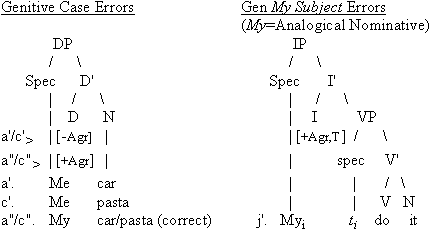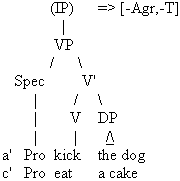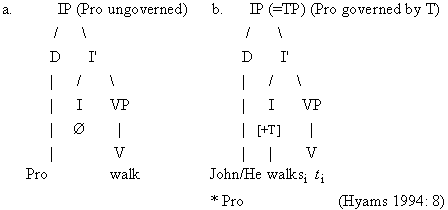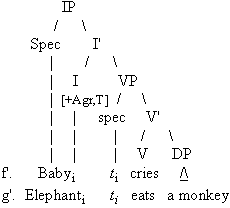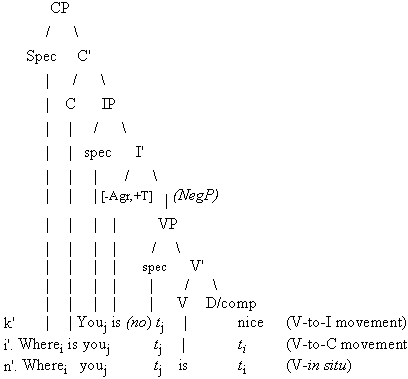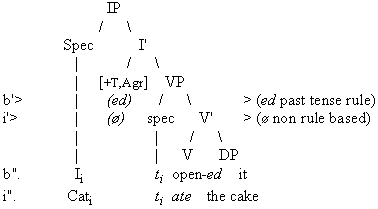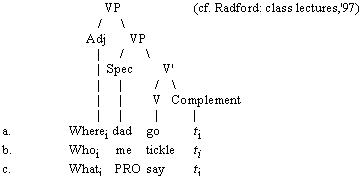
(Additional Errors) Notwithstanding the abundant usage of correct Genitive Case regarding the Optional Stage-2, three further types of errors continue to be reported. (28) gives some token examples: (28)
(*A small set of case errors were found to have Spec-final (N+D) orderings: their significance (albeit few in number) might be linked to a potential Spec-final option in the (preparameterized) grammar (UG)). Similar to what happened regarding feature deficits in IPs, such feature deficits within DPs can equally result in erroneous case assignments with regards to Genitive DP constructions. More specifically speaking, in maintaining that Nominative Case is assigned by a finite [+Agr] feature in I, we may similarly postulate that Genitive Case is assigned by a possessive [+Agr] feature in D.[i] Therefore, by extending the same conditions to DP as we do with respect to formal features of IP, we can assert that D must check-off its formal features (if strong). In examples where correct Genitive Case constructions are only optionally projected (as in the Optional-stage), a tactic approach would be to state an underspecification for that formal D-feature concerned (cf. Radford: class lectures, '97). Consider the following DPs--some of which are Headed by an "Agreement-less" Determiner: (28')
(Regarding the instances of Prenominal/Pronominal Genitive errors (cf. 28g-i), it seems likely that all the child is doing here is wrongly extending the Pronominal version of Gen case (mine) to Prenominal positions (e.g., Mine pasta vs. It my, etc). Since both long/short versions are certainly Genitive, there is nothing more to say). Turning to Genitive My-Subject errors, Radford (class lectures) suggests that My- Subjects could be interpreted as Analogical Nominatives. That is to say, they share the same feature checking processes (i.e., [+Agr] of I) as do their Nominative I subject counterparts.[ii] The view that My-Subjects are Analogical Nominatives also accounts for the fact that they are rarely observed in the environment of 3sg Inflection. Examples such as e.g., My does it are unattested in my data. Without going into details here, the basic premise of his proposal amounts to saying the following: since the overall majority of Genitive Subjects produced by children take the forms of either My or Her (instances of productive use of all other forms e.g., *Our do it remain largely unattested), a conclusion could be drawn that they are not Genitives at all, but are rather Analogical Subjects (in the case of My), and Objective Subjects (in the case of Her). In light of Radford's position on My subjects, all instances of My-subjects (as in example (i) above), would simply be analyzed as a Nominative Subject--being checked by a [+Agr] feature in I. 1.2.4 Pro My data on Null Subjects (=Pros) further suggest a Wexlerian (Optional Infinitive) approach: i.e., the distribution of null subjects seems to follow quite straightforwardly from the specification of I. Schütze (1997: 263) likewise concludes that the licensing of Pro is independent of the feature responsible for checking the case of the subject: Pros may be licensed upon the alteration of [+/-Agr]. While GENs and Pros share possible spell-out with [-Agr], NOMs and Pros share possible spell-out with [+Agr]. The unique spell-out of Pro itself, regardless of Agr, rather crucially depends on the absence of Tense contrasts [-Tense] specification in I (referred to as TP). Thus, according to Schütze, the combined specifications [-T,-/+Agr] may license a Pro.[iii] In unambiguous [+Agr,+T] environments in my data, null subjects don't seem to occur (Nb. Although I don't wish to discount the possibility that (pragmatically-based) Topic/Diary-drop structures may occur within finite main clauses).[iv] Syntactically-based Pros, on the other hand, seem exclusively to occur among the total absence of I specification--i.e., the unspecification of Agr (having to do with phi-features) and T--resulting in [-Agr,-T]. (In fact, I have only one unambiguously Inflected main clause with a Pro in all of my corpus and it seems that it can be attributed to the Neg initial stage No (Pro) works (=Daddy doesn't work)). In a similar vein with Wexler et al. (1996a,b)--who attribute general Case assignment to the specification of Agr (within a finite I) and not Tense--Hyams (1994), Hyams et al (1996a) suggest that the following distributions of Pro may be accounted for in a straightforward way. That is, Pro is licensed by the apparent absence of an Agreement specification in I, and, in particular, the absence of the number feature in D. Hyams (et al.) would therefore predict that Pros occur within non-finite constructions only. This correlation between Pro and unspecification of I is borne out in my data. (Pro in Spec-VP) One alternative way of interpreting such early [-Agr,-T] Pro constructions is to take the more parsimonious Structural Deficit view and propose that Pro, in fact, occupies the Spec of VP--having nothing whatsoever to do with a seemingly vacuous IP projection. Since we already assume that Subjects start out in Spec-VP, a feasible alternative to a Spec-IP structure would be to postulate that Pro simply doesn't raise from out of Spec of VP into the functional projection Spec of I. In adopting this stance, a clearer account can be offered of why and how the unspecifications of Agr and T do occur in early small clauses: mainly, the category that hosts the features simply doesn't project.[v] Consider some token [-Agr,-T] examples of Pro found in my data. (29)
(29')
Moreover, the above VP-analysis is consistent with the view that (big) PRO in adult "To" infinitives is in Spec-VP and not in Spec-IP. This is deduced from the notion that the cliticized wanna--(=want to) in e.g., (I wan-na [VP (PRO) see you])--formation is not blocked by the would be intervening PRO in Spec-IP e.g. (*I wan-(PRO)-na [VP see you]) (see Baltin 1995: 244 cf. Radford: ms1996). However, notwithstanding the given child-to-adult continuity here regarding Pro in Spec-VP, we must still develop a licensing mechanism for dealing with the checking of Pro--be it in Spec-IP or Spec-VP. In fact, a dual licensing of types may be in order here. All missing arguments, including Null Subjects at the lexical/thematic VP-stage (Stage-1), could, in principle, be analyzed as Lexically Saturated items which are considered implicit and thus void of syntactic projection (Radford 1990: 198 ff). In the case of Pros at the small clause VP-stage, there are no (formal) syntactic conditions--hence, it is likely that Pros are freely licensed to occur in any given environment for this stage. Moreover, regarding the approximate target-grammar (Stage-2), we could still follow Schütze (op. cit) and claim that Spec-VP-Pros at the OI-stage are licensed by the outer IP (TP)--similar to what we find with Exceptional Case Marking (ECM). For the child here it may be much the same: although according to my account, Pro would be licensed via the underspecification of Agr and not T. Recall that in Schütze's model, T and Agrs are fused under TP; hence, it becomes natural for Schütze to assume that Pro is licensed by TP since it also encompasses AgrsP as well. In our revised model where T and Agr project (independently) their own Heads and perform separate tasks (viz., as witnessed by the unitary function of the suffix "s" marking T and not Agr (cf. 13)), we do not have the luxury of relying entirely on T as the unique Head Node of the Functional Phrase. Rather, for our purposes concerning a sole Pro licensing, we must consider Agr. For example, in eliciting an AGR as a potential licenser of Spec-VP-Pros (for the OI-stage), a natural inference might be that Pro here is checked by a weak case feature via attraction (and not movement) to the outside IP (=AGR), and that such checking would be done under a non-fused Agr (cf. 15). This might entail that a weak case feature (in AGR) licenses Pro just as it is responsible for the default Accusative case in [-Agr,+T] constructions e.g., Pro/Him goes, and [-Agr,-T] constructions e.g., Pro/Him go, (cf. 16) at the OI-stage). This differs with Schütze in that we now assume that Pro may, in theory, contain a [+T] alongside a [-Agr] specification (Nb. Although Schütze maintains that only the [-T] specification may actually trigger Pros, he nevertheless asserts that the [-Agr] specification is indeed a possible setting for its occurrence. Also, let us note here that such a non-fused T(ensed) P(hrase) which only utilizes a +Interpretable [+T] feature and none of the remaining formal Agreement features may be considered as [-finite] if we wish to define Finiteness as an Agreement relation (e.g., as in the checking of +NOM case with +Finite. See note 15). The Spec-IP-Pro analysis, alternatively, would also be consistent with Chomsky's Pro Theorem (in 33 below) that stipulates that the Functional Head closest to the subject position remain empty. Following Pollock's (1989) original model, in which T and AGR are projected as separated Heads (and not fused), we may still abide by the conditions of the Pro theorem by stating that if Tense is specified [+T], a [-Agr] specification could still elicit Pro--where the nearest Functional Head of AgrsP is void of lexical content: (30)
Drawing attention to the distinctions between a Pro in VP/IP, it is clear that the files presented above suggest that Pro occurs within the Optional-Stage-2. Thus, we are obliged (as discussed above) in projecting an abstract IP [-Agr,-T] (at least for those files starting after file 8 since we have established that the Optional-Stage-2 has begun by file 8). At this juncture, we have the option to either accommodate the Pro-Spec-IP or VP models--whereas only the Spec-IP version would seem to be in accordance with Chomsky's theorem in (33). This alternative licensing of Pro-Spec-IP might be equated with the child's treatment (in some instances) of the default Acc case. Consequentially, this would suggest the following remodeled AGR paradigm of Case for D and I: (31)
This also jibes with a study done by Hyams (1994) where 25% of the verbs used with Pro structures utilized a suffix "s" inflection and 56% utilized a past "ed": (32)
Such findings go hand-in-hand with earlier discussions in this section that sought to define the suffix "s" as a Tense marker and not as an Agreement or dual Tense/Agreement marker. Hyams accounts for such Pros among verbal inflections by making the strong claim that the suffixes "s" and "ed" in child syntax don't actually mark Tense, but rather are Aspectual Participles agreeing with their subjects (i.e., "s" and "ed" mark participial agreement ("s" marking number and not person). There seems to me to be no reason for such child-to-adult Discontinuity regarding the inflections +s/+ed other than, perhaps, to save the Pro theorem in (33): (33)
Hyams asserts that the problem with having a specified T alongside a Pro is that it breaks the condition in (33) shown in (34b) (Hyams here shows overt verb raising to I): (34)
However, if we were to adopt the Spec-VP-Pro analysis for (34a) as discussed above (cf. 29'), then the condition in (33) becomes rather meaningless and is thus no longer valid for the VP stage: i.e., such a Pro in Spec-VP can't be governed by a Functional Head in any case. In addition, if we assume the Pro-Spec-IP analysis (cf.30), the conditions in (33) remain upheld. Radford (contra Hyams) assumes here that such Pros (34b) are in fact null subjects (diary-drops) that can occur in finite clauses. This is deduced from the fact that children produce null subjects (in main clauses) with unambiguous past tense forms (i.e., forms which they don't use after have): (35)
In this sense, since null subjects are being produced with unambiguous [+T], there seems to be some evidence to suggest that the underspecification of Agr [-Agr] might be involved--irrespective of the Tense-feature specification. (As we shall see below, I attempt to expand the distribution of Pros to finite clauses as well (dispensing with the notion of diary drop for the OI-stage)--with the caveat that the clauses aren't really finite at all, but are rather unspecified for Finiteness and merely [+Tense] (See note 15). This, in fact, attempts to unify the theory of Pro in child grammar: i.e., both at the OI and VP stages, null subjects may either occur in non-finite or finite (main clause) utterances: the former deriving Pro with the specifications [-T,-Agr], the latter with [-Agr,+T]. Hence, Non-Noms (e.g. Default Acc and Pros) may serve similar roles here: i.e., their spell outs follow from the design of the syntax itself in that forms lacking any case feature will be given the least specific member of that paradigm (cf. Halle & Marantz: 1993). (In a sense, if the child has, say retrieval problems with the selection of a proper case, she now has two escape paths at her disposal on which to fall back: Acc and Pro. This is not to say that Pro must always function in this default capacity (unlike Acc)--other syntactic factors, including semantic/pragmatics or contextual information, may play a part.). No instances of ProNull subjects in Wh-Questions or Subordinate clauses with [-Agr] specification are borne out from this analysis. (However, see Roeper & Rohrbacher (1994) for reports of Null subjects in non-finite Wh-questions.[vi] Without further expanding on this comment, the rarity of Pros among [-Agr, +/-T] subordinate clauses (e.g. I said *Pro/*him/he want-ed one) could be accounted for in two ways. Firstly, the absence of Pros here could be taken as a sign of the case retrieval mastery by the child--simply speaking, by the time multi-constituent subordinate clauses are acquired, the more primitive default means of potential case spell out has long been abandoned. Furthermore, a notion could be devised whereas once AGR features are correctly specified in the main clause, all AGR specifications in the matrix clause ensue. Secondly, we could resort to the Topic-drop account that restricts Pros from occurring in clause medial positions. Since the distributions of Pro and default Acc. are mutually assigned by [-Agr], their manner of distribution becomes rather difficult to make precise. For instance, the fact that the default Acc shows more frequently than Pro may only demonstrates that the child is utilizing the default in a productive manner, resorting to Pro in exceptional cases. In sum, what we are claiming here are two rather different accounts for the licensing of Pro: (i) Firstly, following Radford (1990), we consider Pros that occur at the VP Stage-1 (the stage that manifest a total underspecification of I) to be lexically saturated Null NPs (np) which are not constrained by syntactic conditions. In this sense, Pro is free to occur within any environment--with the added stipulation that all crucial semantic information is restored at LF. (ii) Secondly, at the Optional-Infinitive Stage-2 (with the onset of T/Agr underspecifications viz., starting from our file 8 onwards), Pros could be alternatively licensed by an empty or underspecified AGR--in accordance with (33b) which states that only a Minimal INFL can check Null Case (we take underspecification of Agr here as constituting a minimal INFL). This results in the possible pairing of Pro with an Inflected V for Tense. The notion that Pros could remain in Spec-VP throughout remains a topic of debate--nothing in my account seems to hinge on this distinction and so I leave it open to question. 1.2.5 Tense Revisited The features of INFL, as already mentioned above, are intricately connected to Case via Agreement--resulting in a myriad of possible hybrid sentences depending upon which specific INFL feature manifest (as in (10') above demonstrating +Agr/-Tns). The main issues regarding INFL seem to me to be centered around notions of Language Specifics as opposed to Language Universals (e.g., Chomsky: 1995). Almost all researchers agree--upon one thing that is--that the emergence of INFL (particularly Tense since Agr may be invisibly marked for English) is paramount in importance for those attempting to locate and /or describe early language separation among bilinguals (cf. Meisel). Whereas the former section was mainly devoted to Agreement (having to do with Case assignment), this section is particularly devoted to looking at the sole distribution of Tense. (3 sg suffix "s") Overt Tense suffix "s" appears productive (i.e., free from any semi-formulaic interpretation) late in my English Data (file 23: 3;2). Once we dispose of ambiguous finite utterance counts (e.g., I go, I cry, etc.) that may mark null [ø] tense, we are left with a seemingly small number of early Tensed "s" forms (recall that we considered it safe to regard ambiguous finite clauses as [-Tense] at least at the early stages). Token examples of later unambiguous 3sg/present [+finite] constructions are given in (36) below *(disregarding early Is+N constructions thought to be formulaic in nature (note 7) (restated from Table 1.6 above):(36)
(36')
(Copulas) A second source of possible early Finite constructions appears in the form of Copula verbs. Examples include (37a-g) for Correct usage, and (37h-n) for Incorrect: (37)
All instances of correct Copula constructions (37a-g)
are to be analyzed as in (7') above--where Aux/Copula verbs are
initially generated under a VP (for thematic purposes) and involve
(V-to-I) raising to the Head of IP. However, one interesting note
about the structures in which copulas show incorrect subject-agreement
is that they appear to have Objective/Acc(usative) Subjects. That
is, not one token example of Incorrect Copula constructions was
found to occur with a Nominative Subject. This might be interpreted
in a number of ways. Foremost, in examples (37i,j,n) the Pronouns
and Wh-elements Here and Where might take on the
role of 3sg superficial Subjects (the Wh-element either
being base-generated or derived) resulting in the verb's 3sg inflection
(with examples like 37h posing a potential problem).[vii] In addition, if Is marks present tense [+T], then You
in examples Where's you? (i), You is no nice (k),
Where you is? (n), would, theoretically, be Objective [-Agr]--on
the grounds that if they were [+Agr] Nominative, we would expect
the verb to inflect for agreement (and hence be Are):
The resulting Incorrect Copula constructions seem to rely on a confusion between the feature matching of the [-Agr] Acc. Subject and the [+T] INFL--where Agr seems to be unspecified. Again, the observation that Nom Case is altogether absent from such constructions reinforces the Optional Stage Hypothesis. (Past "ed" and irregulars) Use of suffix "ed" and irregulars was sporadic even up until the last recording. While irregulars started to be productively used at around File 12, it is not until File 23 that we record the first productive use of "ed". The relatively late onset of the past tense rule "add-ed", as compared to their irregular counterparts, favors the notion that the two processes may be stored very differently in the brain (see note 26). Consider the token examples below that indicate a [+T] specification: (38)
(38')
These findings could be interpreted to suggest that the suffix "ed" comes on-line extremely late in the data owing to its rule-based nature. More specifically, since the "ed" past tense is a result of a morphological rule (which can often be overgeneralized e.g., I wented/goed/hitted), it may require more time for the rule to assert itself into the morphosyntax. The Irregular forms however, being non-ruled-based, are pulled directly from out of the lexicon (in one chunk) and hence, have a scheduled on-line time similar to lexical items.[viii] In this sense, one may very well find at the one/two-word lexical stage utterances containing irregulars: e.g., Daddy did, Me done, All-done, (np) ate, etc. (Aux/"Dummy Do" Insertion) A brief look at the INFL data on Aux/Dummy Do-insertions suggests that semantically light verbs (such as a raised Do) are acquired fairly late in the data--with no instances of aux/modals can, may, will, need, have in the total corpus. In early examples of Negative constructions, (which are unambiguous instances of obliged Do-insertions) no examples of Do-insertions appear. (39)
The lack of light verbs raising here demonstrates that the child relies on a certain amount of semantics for verbal projection--since light verbs, aux/modals are formal categories which lack any real semantic material, the child at the early Lexical/OI-stages may choose to leave them unprojected (see Schütze 1997:) for a broader discussion on the topic where sufficient relevant data is used). 1.3 Final Remarks In sum, a collective picture begins to emerge supporting the notion that unambiguous Finites and Inflection--both being properties of a projected IP--appear fairly late in the data. More specifically, the overall conclusion which the findings reported lead to favors the notion that aspects of Inflectional-Morphology, in Language Acquisition, is on the most part of a protracted nature. The data indicate that a two-stage developmental process of language acquisition is at hand: (i) A Stage-1 Prefunctional Stage (keeping to Radford's original Thesis, cf. Radford: 1990) where No-Functional Categories are present--ultimately resulting in the observed errors found with respect to Case, Agreement/Tense and (ii) A Stage-2 Optional Inflection/Infinitive stage[ix] (cf. Wexler's Hypothesized Optional-Infinitive stage) where we find the (unstable) emergence of the Functional Categories IP/CP, along with the characteristics of Underspecification/Optionality. Moreover, the early emergence of DP (within the VP-stage) was analyzed as having Objective (default) case. This strained any attempt toward maintaining a general D-I correlation. Following Radford & Galasso (ibid), the data presented in this chapter has pointed to an interesting (and previously unreported) symmetry between the general developments of Inflective properties: viz., Subject+Verb constructions on the one hand and Possessive+ Nouns constructions--both constructions showed symmetric-chronological developmental patterning of Inflective markings for 3per/sg +S and possessive 'S (respectively). Again, such data clearly indicated a 2-stage model of acquisition: (i) a No-Inflection-Stage-1, & (ii) a Optional-Inflection-Stage-2 (Stage-3 marking the complete mastery of the target grammar). (Postscriptum)Though I am fully aware that some researchers may wish to analyze the proposed first stage of language development (=stage-1 of my data) as an obligatory Optional Infinitive stage (albeit a first stage where the features of INFL are always present but never specified), I believe, this is hastily concluded. The data thus far presented in this chapter, as well as the previous chapter, when taken as a whole, clearly point to a Two-Stage linguistic development--indicating distinctions between Lexical vs. Functional classifications of language acquisition. It goes without saying that the majority of Data used by those working in developmental linguistics today largely come from the same R. Brown studies (1973) taken from the compilation of The CHILDES Data-base--a collection of corpora which would seem to cast a favorable light on an initial (stage-1) OI-stage (see Stromswold in this chapter). Hence, reasons to collect a more exhaustive Data-Base are more important then ever, as we continue to grapple with all the complexities that language acquisition has to offer. I believe that this corpus has reiterated the classic points initially made by the Maturation/Structure-Building School, and, in so doing, has rightly returned the burden of proof to those who esteem toward Strong Continuity models of child and adult syntax.) [i]
This ties up the notion that all formal/functional categories, whether
it be IP, DP, or CP, are defined in relation to their strong vs
weak features--substantive items (lexical Verbs, Nouns, Adj. etc.)
cannot be defined in such a manner: it is rather meaningless to
speak of lexical categories as having strong vs. weak features.
[ii] Radford considers the idea that the 1st per Pronoun is of the form Stem+affix: Me/My/I= /m+i/, /m+aI/, /ø+aI / so that the My subject is in fact a nominative I with an improper stem. This suggestion is however only one means to account for My subjects in child syntax. Another possibility would be that genitive case is checked by [+Agr] Head--either in D or I in the child syntax (unlike in adult syntax where Genitive must be checked by a Nom [+Agr] Head. In this alternative sense, the child wrongly assumes that only a [+Agr] is needed to check Genitive case--regardless of the Head type. The adult syntax is specific: (i) [+Agr] by a Nominal (D) Head checks Genitive; (ii) [+Agr] by a INFL Head checks Nominative case. [iii]
Schütze (ibid: 188 fn.1) replaces Agr with an Accord relation here
to clarify the meaning of [-Agr]--since nothing hinges on this distinction
with respect to my own analysis, I have taken the liberty to continue
using Agr for sake of continuity.
[iv] One
could make an argument that diary style speech (Diary drop) is pragmatically
based and should not be analyzed in the same manner as syntactic
PROs. In order for the child to create a diary drop structure, the
child must have special awareness of the context and meaning of
intent. It seems plausible to me that young children lack such awareness
and that consequent null subjects generally fall in the class of
PRO.
[v] Again,
the VP analysis here is not so straightforward. Recall our dilemma
faced earlier (cf. 10e-g) regarding the reasoning behind projecting
an abstract IP [-Agr,-T], etc.
[vi] Guilfoyle and Noonan (1988), Radford (1990: 132) have proposed a VP-Adj(unct) analysis for Wh-questions with PRO subjects. In this sense, the Spec of VP may be filled in by a Non-cased nominal, Default Acc, or PRO (a, b, c, respectively):
[vii]
Here are me raises the question of what specification Are
carries. If we assume that it simply specifies [+T], then we have
two entries for [+T] (Is, Are) causing overlap contra principles
of Economy. Radford (pc) has devised a story which suggests that,
in the case that an (+interpretable) default Acc case subject (subject-first
person) is used with an (-interpretable) INFL (verb-second person),
the child creates an anti-crash strategy whereby she only
erases the (-interpretable) INFL features, leaving the Acc subject
feature to survive the derivation even though the INFL features
are mis-matched. In the example of I are, the child cannot
repair the mis-match since the (-interpretable) Nom case can only
be erased when the (-interpretable) Agr features of the subject
match those of INFL. The example Here you am (m)
(=you (+Nom)) eludes such a story and may only
be accounted for by resorting to Pronoun switching (cf. Chiat) whereby
the child switches the intended pronoun with that of the interlocutor--(e.g.,
Here you am=Here I am).
[viii]
See Marcus, Clahsen et al. (1996) for their psychological studies
that support the view that regular vs. irregular morphologies are
stored quite differently in the brain.
[ix] Radford
(cf. ms Radford et Galasso) makes reference to this observed optional
stage-2 as an Optional-Inflection stage--whereas, contra
Wexler, OIs refer to tense/finiteness, the term here applies to
Inflection.
|
|||||||||||||||||||||||||||||||||||||||||||||||||||||||||||||||||||||||||||||||||||||
